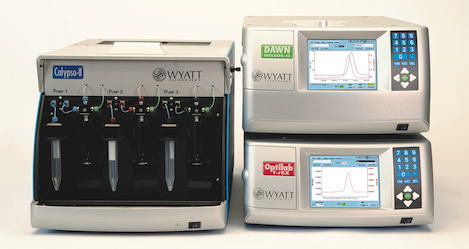Members Login

Channels
Special Offers & Promotions
Wyatt Technology

Study published in Nature outlines use of Wyatt’s Calypso II system to confirm the stoichiometry of αSNAP-SNARE complex
Wyatt Technology Corporation, the world leader in instrumentation for absolute macromolecular and nanoparticle characterization, is pleased to highlight a new study that describes the use of composition-gradient multi-angle light scattering (CG-MALS) for the characterization of complex protein-protein interactions. The study, entitled ‘Mechanistic insights into the recycling machine of the SNARE complex’, was published in the February 5, 2015 issue of Nature. The authors demonstrate the benefits of CG-MALS for identifying the stoichiometry of the complex formed upon hetero-association between αSNAP (soluble NSF attachment protein) and SNARE (soluble N-ethylmaleimide sensitive factor attachment protein receptors) using Wyatt Technology’s Calypso® biomolecular interaction system.
Membrane fusion is essential for many physiological processes in eukaryotic cells including protein and membrane trafficking, hormone secretion and neurotransmission. Evolutionary SNARE proteins have a key role in these processes as they form a complex that drives membrane fusion in eukaryotes. The ATPase NSF (N-ethylmaleimide sensitive factor), together with SNAPs, disassembles the SNARE complex into its protein components, allowing for subsequent rounds of fusion. Due to the low resolution limits of techniques used for structural studies into the NSF/SNAP/SNARE (20S) supercomplex, little is known about the detailed molecular architecture of the supercomplex.
CG-MALS quantifies biomolecular interactions by measuring the protein solution’s weight-average molar mass (Mw) over a series of concentrations and compositions. The analysis establishes the binding affinity and molecular stoichiometry of a large variety protein-protein interactions, including self- and hetero-association. The study at hand showcases the use of CG-MALS to help resolve critical questions, such as how the adaptor protein SNAP recognizes and interacts with SNARE complexes, as well as the mechanism for disassembly.
CG-MALS experiments are performed with a Calypso II composition gradient system, programmed to automatically prepare and deliver different mixtures of protein and buffer to a DAWN® HELEOS® II multi-angle light scattering detector and an on-line UV/Vis concentration detector. Data are acquired and analyzed in the unique CALYPSO software to determine the association scheme and equilibrium dissociation constants. By quantifying any self-association and assessing the hetero-interaction between αSNAP and each SNARE complex, it was possible to confirm cryo-EM structures that provided a working model of NSF-mediated SNARE complex disassembly.
“The absolute characterization of complex protein-protein interactions such as the SNAP-SNARE system demonstrated in this study can prove challenging. Traditional techniques do not provide the required level of detail on the affinity and absolute molecular stoichiometry of these complexes, which means that critical scientific questions remain unanswered,” explains Dr. Daniel Some, Director of Marketing and Principal Scientist at Wyatt Technology, “The Calypso II enables the rapid quantification and in-depth characterization of biomolecular interactions, label-free and immobilization-free, complementing other biomolecular interaction techniques. We are delighted that this study has been published in Nature to continue to raise awareness of the versatile capabilities of CG-MALS for life science research and biotherapeutic development.”
In a related development, Wyatt recently published a study carried out at the Scripps Research Institute, detailing how CG-MALS operates in tandem with size-exclusion chromatography coupled to MALS (SEC-MALS) to fully characterize the interaction of a viral glycoprotein (vGP) with an antibody (Ab). In the application note “Understanding Antibody and Viral Glycoprotein Interactions Using CG-MALS,” SEC-MALS established the dimeric state and degree of glycosylation of vGP, while CG-MALS quantified vGP self-association along with the stoichiometry and binding affinity of the vGP – Ab interaction. This powerful combination of light scattering techniques made it possible to decipher the vGP-Ab interaction with greater detail than was previously known. This study yielded valuable information regarding the potential epitope for the antibody, which is essential for formulating post-exposure treatments or designing antigens for vaccine production. This study is available to download at www.wyatt.com/AppNotes/CG-MALS
Media Partners


